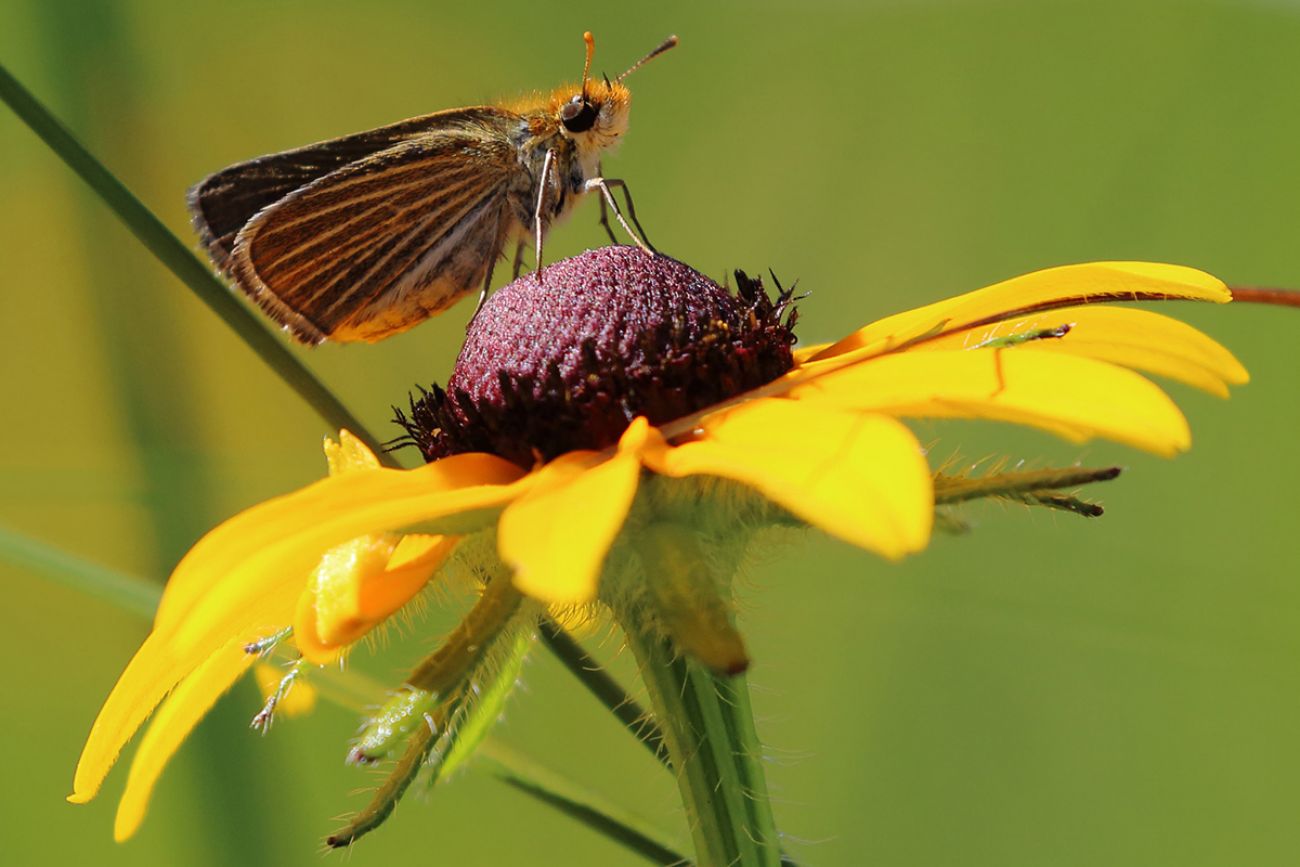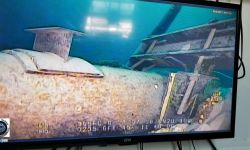A rare butterfly makes last stand in Michigan. Feds have $57M plan to save it

Less than 300 butterflies no bigger than a human thumbnail are the focus of a multi-million dollar, decades-long conservation effort in southeast Michigan.
The U.S. Fish and Wildlife Service on Tuesday released a $57 million, 50-year recovery plan for the Poweshiek skipperling, a critically endangered butterfly species only found in Oakland County and Manitoba, Canada.
The skipperling is on the verge of extinction after once fluttering about in 300 sites across the Midwest and prairie states. That prompted an international group of more than 70 partners to work to stabilize populations in hopes of removing them from the endangered species list.
Related:
- Michigan scraps special elk hunt in January
- Daily trout limits in Lake Huron may be reduced due to overfishing
The skipperling — a fuzzy, brown butterfly that resembles a moth — had thrived in prairie regions like fens from the upper Midwest to the Dakotas, but it’s uncertain why the populations collapsed, Tamara Smith, a U.S. Fish and Wildlife biologist.
Likely culprits are habitat loss, droughts and pesticides, she said.
“It’s probably a combination of different stressors that caused the widespread and rapid decline that we saw in the 1990s and 2000s,” Smith said.
The recovery plan focuses on reintroducing the skipperling and rehabilitating environments where they can thrive through partnerships with zoos and universities.
Springfield Township in northern Oakland County has one of two remaining wild Poweshiek skipperling populations, according to Mike Losey, the township’s natural resources manager.
Losey said the state’s skipperling population has survived in small numbers because fens along the Shiawassee River Corridor remain unharmed.
“We have a high-quality habitat that it can exist in, which is buffered by other natural land cover that provides a buffer from (pesticides),” Losey said.
Wildlife experts are hesitant to disclose the location of the fen because of its sensitivity and its endangered inhabitants, including Michigan’s only venomous snake, the Massasauga rattlesnake, and the Blanding’s turtle.
Losey said it's very likely that less than 100 skipperlings are in Springfield Township. Part of the reason their populations struggle to grow is the survival rate from egg to adult in the wild is very low.
“Perhaps only 2 percent or so of the eggs become adults,” Losey said.
The Poweshiek skipperling has a short adult life, about two to four weeks in the summer, and needs lots of nectar from flowers, like wild black-eyed Susans, and grass to lay eggs. The larvae also rely on grass, which they feed on throughout the summer, and humid temperatures.
Losey said the township does its best to “enhance and maintain the prairie fens in ways that allow the diversity of plant life to thrive.”
Such efforts include routinely removing invasive species and prescribed burning of the land which helps encourage native plants to thrive, including the ones Losey suspects host Poweshiek skipperling larvae.
Even with the township’s efforts, the skipperling populations need a head start, which is why zoos and universities have teamed up to captively breed the butterfly.
There are about 500 Poweshiek skipperling larvae kept in zoos now, according to Smith, the wildlife biologist. The plan is to reintroduce some of those larvae into the Springfield fens as adults this summer.
The Grand Rapids John Ball Zoo and the Haddad Lab and Michigan State University in 2019 joined forces to breed the butterflies in captivity. Last year, the team consistently bred the skipperlings for the first time.
David Pavlik, a research assistant at the Haddad Lab, said the team has created an insurance population so that if the butterfly goes extinct in the wild, they could still survive in captivity to give them a fighting chance.
“We now have excess (butterflies) we don’t need for that insurance population, and we want to get them back into the wild to bolster the current populations,” Pavlik said.
One of the major goals is to raise enough butterflies to do large reintroductions, Pavlik said. The lab is planning on introducing about 100 adult skipperlings to the Springfield fen in June—the largest release ever occurred.
Pavlik said the hope is that eventually the zoos and labs will begin introducing the butterflies in large numbers to the areas where they no longer exist. The recovery plan’s delisting goal is to have populations across Manitoba, the Dakotas, Minnesota, Michigan, Wisconsin, and Illinois.
“We have partners restoring that habitat back to what the skipperlings like,” Pavlik said. “Hopefully we can get them back into those areas to create new populations and prevent their extinction.”
Susan Julian, the executive director of Blue Heron Headwaters in Oakland County, is among the collaboration’s partners working to conserve the sensitive habitats favored by skipperlings.
Julian’s organization was founded in 1972 when the U.S. Clean Water Act was published and environmental awareness increased. For more than 20 years, homeowners donated small areas of land.
In 2008, as land between Pontiac and Flint became more developed, the group’s focus changed.
“Now we find ourselves negotiating and having to raise money to buy land and the pace of preservation has slowed because of that,” Julian said.
For the past decade, Julian’s organization has been involved in protecting the areas in Oakland County that the Poweshiek skipperlings occupy. When the butterfly populations are robust, “that’s where our conservancy comes in,” Julian said.
“We have an easement on land where there’s an existing population, but we’re trying to add the same kind of fen habitat and improve it so that it will be a site where a new population can start,” Julian said.
The conservancy has 40 acres and wants to add 10 to 16 acres onto it which are currently in the hands of private landowners.
It can take years to rehabilitate wetlands, and fens are particularly hard to restore. According to the U.S. Forest Service, fens are peat-forming wetlands supplied by ground and take thousands of years to develop which means they can’t be easily restored once they’re destroyed.
“It leads to certain kinds of plant life which then dictates the kind of wildlife that’s there,” Julian said.
Julian said the fight is about more than just saving the Poweshiek skipperling because they are “the canary in the coal mine,” an early warning about ecological dangers that could threaten the rest of the area.
“They grow in a specific environment that the environment itself needs protecting in order to protect a whole lot of other species, plants and animals,” Julian said.
Michigan Environment Watch
Michigan Environment Watch examines how public policy, industry, and other factors interact with the state’s trove of natural resources.
- See full coverage
- Subscribe
- Share tips and questions with Bridge environment reporter Kelly House
Michigan Environment Watch is made possible by generous financial support from:
Our generous Environment Watch underwriters encourage Bridge Michigan readers to also support civic journalism by becoming Bridge members. Please consider joining today.
See what new members are saying about why they donated to Bridge Michigan:
- “In order for this information to be accurate and unbiased it must be underwritten by its readers, not by special interests.” - Larry S.
- “Not many other media sources report on the topics Bridge does.” - Susan B.
- “Your journalism is outstanding and rare these days.” - Mark S.
If you want to ensure the future of nonpartisan, nonprofit Michigan journalism, please become a member today. You, too, will be asked why you donated and maybe we'll feature your quote next time!






